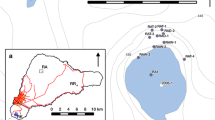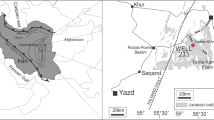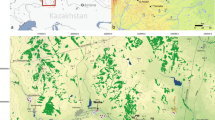Abstract
As a part of the ELSA-project (Eifel Laminated Sediment Archive) new pollen and plant macro-remain analyses have been carried out on a series of Holocene lacustrine sediments from three open maar lakes of the Quaternary Westeifel Volcanic Field. In combination with already existing pollen analyses, the archaeological record and written sources, the present study casts new light on settlement activities and henceforth the development of agriculture from the prehistoric to historic times in this region. While there are clues that wood pasturing was practised in the Eifel region from the Michelsberg Culture onwards (c. 4300 cal. b.c.), the Vulkaneifel is a remote area with relatively poor soils and a humid climate and was not constantly settled until the Late Neolithic/Early Bronze Age, when cereal pollen was found regularly in the deposits. Plant macro-remains (chaff), which give us direct evidence for arable agriculture in the surroundings of the maars, were also found in layers belonging to the Early Bronze Age (c. 1900 cal. b.c.). At the same time we can observe the massive spread of Fagus sylvatica (beech) in all pollen diagrams, which was most probably caused by a combination of climatic, anthropogenic and competitive factors. Later impacts of agriculture were an abundance of crop weeds and pollen in the following Middle Bronze Age. Nevertheless human impact remained discontinuous until the Urnfield Culture (1200–800 cal. b.c.). A layer of weeds dating at the end of the Urnfield Culture was found and also flax (Linum usitatissimum) cultivation first becomes apparent. However, the subsequent Iron Age and Roman Period reveal only crop weeds and cereal pollen in slightly higher concentrations, but the abundance of Poaceae pollen at this time is most probably consistent with grazing activities. There follows compelling evidence of the importance of flax cultivation and processing at the maars from the Merovingian Period (5th century a.d.) onwards. A detailed insight into the agriculture of the High Medieval comes from flash flood layers of the 14th century a.d., where remains of Secale cereale (rye) and crop weeds reflect winter-sown cultivation of rye. Cannabis sativa (hemp) was also cultivated and processed during the medieval. Finally we can trace the Prussian reforestation in the 19th century a.d., with an increase in Pinus sylvestris (pine) and Picea abies (fir), by both pollen and plant macro-remains.








Similar content being viewed by others
References
Baier J, Lücke A, Negendank JFW, Schleser GH, Zolitschka B (2004) Diatom and geochemical evidence of mid- to late Holocene climatic changes at Lake Holzmaar, West-Eifel (Germany). Quat Int 113:81–96
Behre KE (1992) The history of rye cultivation in Europe. Veget Hist Archaeobot 1:141–156
Berglund BE, Ralska-Jasiewiczowa M (1986) Pollen analysis and pollen diagrams. In: Berglund BE (ed) Handbook of Holocene palaeoecology and palaeohydrology. Wiley, Chichester, pp 455–484
Beug HJ (2004) Leitfaden zur Pollenbestimmung für Mitteleuropa und angrenzende Gebiete. Pfeil, München
Bienert B (2008) Merowingerzeitliche Besiedlung—Archäologische Befunde in den südlichen Rheinlanden. In: Irsigler F (ed) Geschichtlicher Atlas der Rheinlande IV.13. Habelt, Bonn
Birks HH, Birks HJB (2000) Future uses of pollen analysis must include plant macrofossils. J Biogeogr 27:31–35
Bleicher N, Sirocko F (2009) Weiträumiger Kulturwandel am Beginn der einsetzenden Abkühlungen Mitteleuropas. In: Sirocko F (ed) Wetter, Klima, Menschheitsentwicklung. Theiss, Stuttgart, pp 119–123
Bork HR, Dalchow C, Faust B, Piorr HP, Schatz T (1998) Landschaftsentwicklung in Mitteleuropa. Klett-Perthes, Gotha
Brauer A, Litt T, Negendank JFW, Zolitschka B (2001) Lateglacial varve chronology and biostratigraphy of lakes Holzmaar and Meerfelder Maar, Germany. Boreas 30:83–88
Brück J, Frey M (2001) Römische Villa und keltische Tradition. In: Rieckhoff S, Biel J (eds) Die Kelten in Deutschland. Theiss, Stuttgart, pp 442–445
Büchel G (1993) The maars of the Westeifel, Germany. In: Negendank JFW, Zolitschka B (eds) Paleolimnology of European Maar Lakes. Springer, Berlin, pp 1–13
Cappers RTJ, Bekker RM, Jans JEA (2006) Digitale Zadenatlas van Nederland. Groningen Archaeological Studies 4. Barkhuis, Groningen
Conrady D, Herhaus F, Wasner U (2007) Niederwald und Naturschutz in NRW. Eine Einführung. In: Landesamt für Natur, Umwelt und Verbraucherschutz Nordrhein-Westfalen (LANUV) (ed) Niederwälder in Nordrhein-Westfalen. Beiträge zur Ökologie, Geschichte und Erhaltung. LANUV Fachbericht 1, Recklinghausen, pp 9–16
Cüppers H, Rüger CB (1985) Römische Siedlungen und Kulturlandschaften. Geschichtlicher Atlas der Rheinlande. Beih. III/1–III/2. Rheinland Verlag, Trier
Dickinson RE (1961) Germany: A general and regional geography. Methuen, London
Dickson C (1988) Distinguishing cereal from wild grass pollen: some limitations. Circaea 5:67–71
Diehl M (2007) Palynologie und Sedimentologie der Interglazialprofile Döttingen, Bonstorf, Munster und Bilshausen. Unpubl. PhD thesis, J. Gutenberg-Universität, Mainz
Dörfler W (1990) Die Geschichte des Hanfanbaus in Mitteleuropa aufgrund palynologischer Untersuchungen und von Großrestnachweisen. Prähist Zeitschr 65:218–244
Dörfler W, Evans A, Nakoinz O, Usinger H, Wolf A (2000) Wandel der Kulturlandschaft als Ausdruck kulturellen Wandels? Pollenanalytische und siedlungsarchäologische Untersuchungen zur Romanisierung in der Vulkaneifel. In: Haffner A, von Schnurbein S (eds) Kelten, Germanen, Römer im Mittelgebirgsraum zwischen Luxemburg und Thüringen. Habelt, Bonn, pp 129–146
Ellenberg E (1996) Vegetation Mitteleuropas mit den Alpen in ökologischer, dynamischer und historischer Sicht. Ulmer, Stuttgart
Fægri K, Iversen J (1989) Textbook of pollen analysis, 4th edn. Wiley, New York
Goldammer JG, Montag S, Page H (1997) Nutzung des Feuers in mittel- und nordeuropäischen Landschaften. Geschichte, Methoden, Probleme. Perspektiven. NNA-Berichte 10:18–38
Gronenborn D, Sirocko F (2009) Viehwirtschaft und die Ausbreitung der Michelsberger Kultur. In: Sirocko F (ed) Wetter, Klima, Menschheitsentwicklung. Theiss, Stuttgart, pp 116–118
Hajdas I, Zolitschka B, Ivy-Ochs S, Beer J, Bonani G, Leroy AG, Negendank JW, Ramrath M, Suter M (1995) AMS radiocarbon dating of annually laminated sediments from lake Holzmaar, Germany. Quat Sci Rev 14:137–143
Hajdas I, Bonani G, Zolitschka B (2000) Radiocarbon dating of varve chronologies: soppensee and Holzmaar after 10 years. Radiocarbon 42:349–354
Harzheim G, Krause M, Stender D (2001) Gewerbe- und Industriekultur in der Eifel. Bachem, Köln
Heinz T, Rein B, Negendank JFW (1993) Sediments and basin analysis of Lake Schalkenmehrener Maar. In: Negendank JFW, Zolitschka B (eds) Paleolimnology of European maar lakes. Springer, Berlin, pp 149–161
Henrich P (2006) Die römische Besiedlung in der westlichen Vulkaneifel. Trierer Zeitschrift/Beiheft 30. Rheinisches Landesmuseum, Trier
Hummel M (1949) Zur postglazialen Wald-, Siedlungs- und Moorgeschichte der Vordereifel. Planta 37:451–497
Hunold A, Sirocko F (2009) Klimagunst und die Blütezeit des Römischen Reiches. In: Sirocko F (ed) Wetter, Klima, Menschheitsentwicklung. Theiss, Stuttgart, pp 144–149
Jacomet S, Kreuz A (1999) Archäobotanik. Ulmer, Stuttgart
Jacomet S, Brombacher C, Dick M (1989) Archäobotanik am Zürichsee. Neue Medien, Zürich
Joachim H (1997) Bronze- und Eisenzeit. In: Irsigler F, Straßer R (eds) Geschichtlicher Atlas der Rheinlande. Beiheft II/3.1–II/3.4. Rheinland, Köln
Kalis AJ, Meurers-Balke J (1997) Landnutzung im Neolithikum. In: Irsigler F, Straßer R (eds) Geschichtlicher Atlas der Rheinlande, Beiheft II/2.1–II/2.2. Rheinland-Verlag, Köln, pp 25–46
Körber-Grohne U (1990) Gramineen und Grünlandvegetation vom Neolithikum bis zum Mittelalter. Bibliotheca Botanica 139. Schweizerbart, Stuttgart
Kubitz S (2000) Die holozäne Vegetations- und Siedlungsgeschichte in der Westeifel am Beispiel eines hochauflösenden Pollendiagramms aus dem Meerfelder Maar. Diss Bot 339, Cramer, Stuttgart Berlin
Kühl N, Moschen R, Wagner S, Brewer S, Peyron O (2010) A multiproxy record of late Holocene natural and anthropogenic environmental change from the Sphagnum peat bog Dürres Maar, Germany: implications for quantitative climate reconstructions based on pollen. J Quat Sci 25:675–688
Küster HJ (1992) Die Geschichte des Grünlandes aus pollenanalytischer und archäobotanischer Sicht. In: Akademie für Naturschutz und Landschaftspflege (ed) Wald oder Weideland. Zur Naturgeschichte Mitteleuropas. Laufener Seminarbeiträge, Laufen/Salzach, pp 9–13
Lehné R, Sirocko F (2009) Geologie und Entstehung der Maare. In: Sirocko 2009 (ed) Wetter, Klima, Menschheitsentwicklung. Theiss, Stuttgart, pp 10–13
Leroy AG, Zolitschka B, Negendank JFW, Seret G (2000) Palynological analyses in the laminated sediment of Lake Holzmaar (Eifel, Germany): duration of Lateglacial and Preboreal biozones. Boreas 29:52–71
Litt T (2004) Eifelmaare als Archive für die Vegetations- und Klimageschichte der letzten 15000 Jahre. Ber RTG 16:87–95
Litt T, Stebich M (1999) Bio- and Chronostratigraphy of the Lateglacial in the Eifel Region, Germany. Quat Int 61:5–16
Litt T, Brauer A, Goslar T, Merkt J, Balaga K, Ralska-Jasiewiczowa M, Stebich M, Negendank JFW (2001) Correlation and synchronisation of Lateglacial continental sequences in northern and central Europe based on annually laminated lacustrine sediments. Quat Sci Rev 20:1,233-1,249
Litt T, Schölzel C, Kühl N, Brauer A (2009) Vegetation and climate history in the Westeifel Volcanic Field (Germany) during the past 11,000 years based on annually laminated lacustrine maar sediments. Boreas 38:679–690
Lücke A, Schleser GH, Zolitschka B, Negendank JFW (2003) A Lateglacial and Holocene organic carbon isotope record of lacustrine palaeoproductivity and climatic change derived from varved sediments of Lake Holzmaar, Germany. Quat Sci Rev 22:569–580
Möller L, Vogel M (eds) (2007) Die Naturgeschichte des Caius Plinius Secundus. Marix, Wiesbaden
Nakoinz O (1998) Siedlungsarchäologische Untersuchungen im Umfeld des Holzmaares in der Eifel. Unpubl. Diploma Thesis, Kiel University
Negendank JFW, Zolitschka B (1993) Maars and maar lakes of the Westeifel Volcanic Field. In: Negendank JFW, Zolitschka B (eds) Paleolimnology of European Maar Lakes. Springer, Berlin, pp 61–80
Nickel C (2007) Keltischer Kult am Martberg. In: Uelsberg Gabriele (ed) Krieg und Frieden. Kelten–Römer–Germanen, Primus, pp 184–187
Löhr H, Nortmann, H (2008) Sichtbares und Unsichtbares. In: Rheinisches Landesmuseum Trier (ed) Führer zu Archäologischen Denkmälern des Trierer Landes. Dillingen/Saar, pp 11–33
Oberdorfer E (2001) Pflanzensoziologische Exkursionsflora. Ulmer, Stuttgart
Parker AG, Goudie AS, Anderson DE, Robinson MA, Bonsall C (2002) A review of the mid-Holocene elm decline in the British Isles. Prog Phys Geogr 26:1–45
Richter J (1997) Neolithikum. In: Irsigler F, Straßer R (eds) Geschichtlicher Atlas der Rheinlande II.2.1–II/2.2, Rheinland Verlag, Köln
Schaber K, Sirocko F (2005) Lithologie und Stratigraphie der spätpleistozänen Trockenmaare der Eifel. Mainzer Geowiss Mitt 33:295–340
Schwind W (1984) Der Eifelwald im Wandel der Jahrhunderte ausgehend von Untersuchungen in der Vulkaneifel. Eifelverein Düren
Sirocko F, Seelos K, Schaber K (2006) Das ELSA-Kernlager: Archiv der Entwicklung von Klima, Umwelt und Vulkanismus in Rheinland-Pfalz. Natur und Geist 2:16–19
Sirocko F, Dietrich S, Veres D, Grootes P, Schaber-Mohr K, Seelos K, Nadeau M-J, Kromer B, Rothacker L, Röhner M, Krbetschek M, Appleby P, Hambach U, Rolf C, Sudo M, Grim S (in press) Multi-Proxy-Dating of Holocene maar lakes and Pleistocene dry maar sediments in the Eifel, Germany. Quat Sci Rev
Smettan HW (1989) Der Cannabis/Humulus-Pollentyp und seine Auswertung im Pollendiagramm. In: Körber-Grohne U, Küster H (eds) Archäobotanik. Diss Bot 133, Cramer, Stuttgart, Berlin, pp 25–40
Stockmar J (1971) Tables with spores used in absolute pollen analysis. Pollen Spores 13:612–621
Straka H (1975) Die spätquartäre Vegetationsgeschichte der Vulkaneifel. Beitr Landespflege Rheinland-Pfalz 3:1–163
Thoma M (2007) Häuser der Götter auf dem Martberg. In: Uelsberg Gabriele (ed) Krieg und Frieden. Kelten–Römer–Germanen, Primus, pp 188–191
Usinger H (1982) Pollenanalytische Untersuchungen an spätglazialen und präborealen Sedimenten aus dem Meerfelder Maar (Eifel). Flora 172:373–409
Usinger H (1984) Pollenanalytische Untersuchungen zum Alter des Meerfelder Maares und zur Vegetationsentwicklung in der Westeifel während der ausklingenden Eiszeit. Cour Forsch-Inst Senckenberg 65:49–66
Usinger H, Wolf A (1991) Pollenanalytische Untersuchungen an jahresgeschichteten spät- und postglazialen Sedimenten des Holzmaares (Eifel). In: Zolitschka B, Negendank JFW (eds) Paleolimnology of maar lakes: Abstracts and Excursion Guide, pp 56
von Berg A (1995) Eine Siedlung des frühen Mittelalters bei Mayen-Hausen. Mayener Beiträge zur Heimatgeschichte 7:3–28
Von Berg A (2006) Von den Anfängen der Metallverarbeitung bis zur mittleren Bronzezeit. In: Kunow J, Wegner HH (eds) Urgeschichte im Rheinland. Rheinischer Verein für Denkmalpflege und Landschaftsschutz, Köln, pp 205–222
Wegner HH (2006) Die Eisenzeit im rheinischen Gebirge und am Mittelrhein. In: Kunow J, Wegner HH (eds) Urgeschichte im Rheinland. Rheinischer Verein für Denkmalpflege und Landschaftsschutz, Köln, pp 255–276
Wegner HH (2007) Die Kelten an Mittelrhein und Mosel. In: Uelsberg Gabriele (ed) Krieg und Frieden. Kelten–Römer–Germanen, Primus, pp 59–78
Wiethold J (2000) Kontinuität und Wandel in der landwirtschaftlichen Produktion und Nahrungsmittelversorgung zwischen Spätlatènezeit und gallo-römischer Epoche. Archäobotanische Analysen in der römischen Großvillenanlage von Borg, Kr. Merzig-Wadern. In: Haffner A, von Schnurbein S (eds) Kelten, Germanen, Römer im Mittelgebirgsraum zwischen Luxemburg und Thüringen. Habelt, Bonn, pp 160–173
Wirtgen P (1865) Ueber die Vegetation der hohen und vulkanischen Eifel. Verh naturhist Ver preuss Rheinlande und Westphalens 22:63–291
Zolitschka B (1992a) Climatic change evidence and lacustrine varves from maar lakes, Germany. Clim Dyn 6:229–232
Zolitschka B (1992b) Human history recorded in the annually laminated sediments of Lake Holzmaar, Eifel Mountains, Germany. Geol Surv Finland Spec Paper 14:17–24
Zolitschka B, Negendank JFW (1998) High resolution record of Holocene palaeoenvironmental changes from Lake Holzmaar, Germany. Paläoklimaforschung 25, ESF Special Issue 17:37–52
Acknowledgments
Pollen preparation and analysis were carried out by F. Dreher (University of Mainz). The first author thanks the ‘Stiftung Rheinland-Pfalz für Innovation’ and the Cluster Geocycles for financing the studies. He is also grateful to Ursula Maier (Cultural Heritage Agency, Baden-Württemberg) for additional help with the identification, to Klaus Schwibus (University of Mainz) for wet sieving of samples with great care and accuracy, to Petra Sigl for assisting with the graphics also to Sabine Hornung (University of Mainz), Astrid Stobbe and Tanja Zerl (both from University of Frankfurt/Main) for discussion of the archaeobotanical and archaeological backgrounds of the Eifel region. Finally we would like to thank John Hodgson and Catherine Longford (both University of Sheffield, England) for improving the English.
Author information
Authors and Affiliations
Corresponding author
Additional information
Communicated by T. Litt.
Electronic supplementary material
Below is the link to the electronic supplementary material.
Rights and permissions
About this article
Cite this article
Herbig, C., Sirocko, F. Palaeobotanical evidence for agricultural activities in the Eifel region during the Holocene: plant macro-remain and pollen analyses from sediments of three maar lakes in the Quaternary Westeifel Volcanic Field (Germany, Rheinland-Pfalz). Veget Hist Archaeobot 22, 447–462 (2013). https://doi.org/10.1007/s00334-012-0387-6
Received:
Accepted:
Published:
Issue Date:
DOI: https://doi.org/10.1007/s00334-012-0387-6




